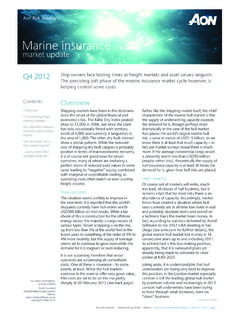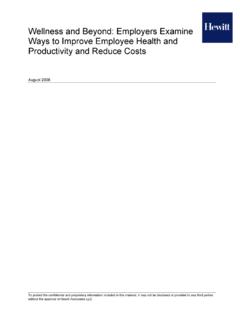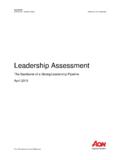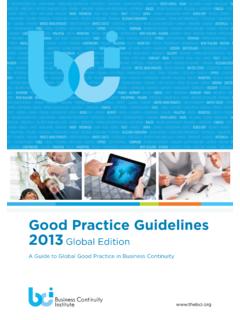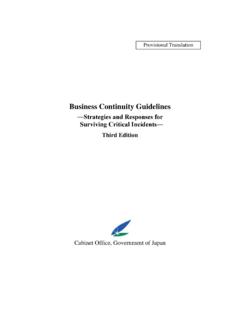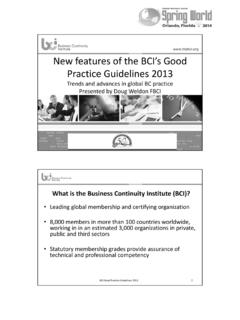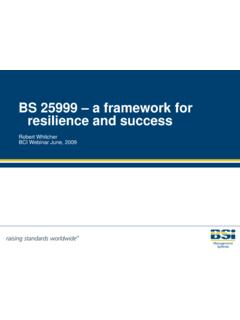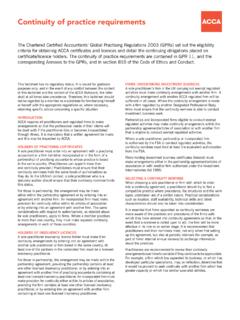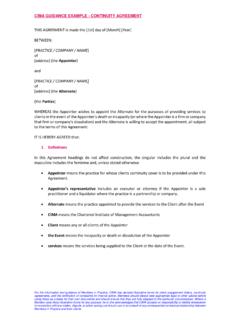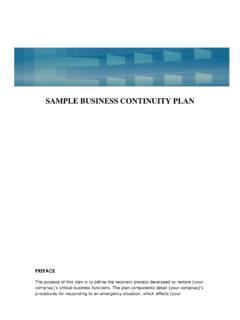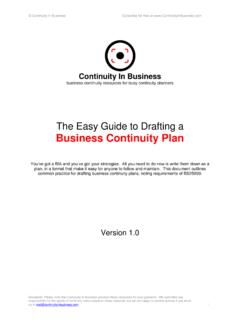Transcription of The Importance of Conducting Maturity Assessments for …
1 Aon Risk Solutions Aon Global Risk Consulting | Business continuity Management Risk. Reinsurance. Human Resources. The Importance of Conducting Maturity Assessments for your Business continuity Management Program Aon Risk Solutions Aon Global Risk Consulting | Business continuity Management T he Importance of Conducting Maturity Asse ssments for your Business continuity Management Program 1 Business continuity Management (BCM) is the framework developed by an organization to identify their risk of exposure to internal and external threats and to ensure business continuity is maintained across their organization. According to Disaster Recovery International1, Business continuity Planning is The strategic and tactical capability of the organization to plan for and respond to incidents and business disruptions in order to continue business operations at an acceptable predefined level.
2 Ultimately, the goal of BCM is to provide organizations with the ability to efficiently and effectively respond to threats such as supply chain disruptions, natural disasters or cyber/data breaches, and protect the business interests of the organization. Driving Maturity in Business continuity Management Programs Today, many organizations are seeking formal accreditation and certification for their Business continuity Management programs. In 2007, the Department of Homeland Security (DHS) and the Federal Emergency Management Agency (FEMA) established and implemented the voluntary private sector preparedness accreditation and certification program, PS-Prep . This program is designed to help private sector and not-profit organizations institute a comprehensive business continuity management system that addresses business continuity , organizational resilience, emergency and disaster management.
3 PS-Prep incorporates three key industry standards and offers organizations the opportunity to develop and maintain certification to comply with nationally recognized and respected approaches to resilience and preparedness. The first step in determining readiness is to identify the standard to which organizations should become certified in preparation for a PS-Prep third party audit. The three standards are: ISO 22301:2012: Societal security -- Business continuity management systems NFPA 1600: Disaster/Emergency Management and Business continuity Programs, 2013 edition ASIS International , Organizational Resilience: Security, Preparedness and continuity Management Systems Requirements with Guidance for Use Standards Aon Global Risk Consulting has developed a BCM Maturity assessment Workbook which is based on two of the recognized industry standards (NFPA 1600 and ISO 22301) that enable organizations to implement an assessment benchmark against best practices.
4 The workbook consists of a menu of requirements/benchmark/comparisons and a best practice compliance aggregation dashboard founded upon recognized standards, including National Fire Protection Association (NFPA) 1600 - Standard on Disaster / Emergency Management and Business continuity Programs and 2013 and ISO 22301: Societal Security Business continuity Management Systems, 2012. Note: The BCM Maturity assessment is designed to determine whether the applicable best practice processes have been followed as part of the preparedness plan. It is not intended to validate the viability or effectiveness of the plan. Beyond these standards, there are other codes and standards that address the technical aspects of planning, such as evacuation and sheltering in place etc.
5 That need to be considered as part of business continuity plan development, depending on specific organizational requirements. 1 Disaster Recovery International is the leading nonprofit that helps organizations around the world prepare for and recover from disasters by providing education, accreditation, and thought leadership in business continuity and related fields. Aon Risk Solutions Aon Global Risk Consulting | Business continuity Management T he Importance of Conducting Maturity Asse ssments for your Business continuity Management Program 2 ISO and NFPA Standards, and How They Drive Structured Preparedness ISO (International Organization for Standardization) is a worldwide federation comprised of national standards bodies.
6 International Standards are typically prepared by technical committees. The ISO standard, ISO 22301, "Societal security -- Preparedness and continuity Management Systems -- Requirements", specifies requirements for setting up and managing an effective Business continuity Management System (BCMS). ISO 22301 specifies the requirements for a management system to protect against, reduce the likelihood of, and ensure your business recovers from disruptive incidents. ISO 22301 is recognized in most countries as the main business continuity standard or framework. The National Fire Protection Association (NFPA), a United States trade association which includes international members, creates and maintains private, copyrighted, standards and codes for usage and adoption by local governments.
7 NFPA 1600 is the Standard on Disaster/Emergency Management and Business continuity Programs , prepared by the Technical Committee on Emergency Management and Business continuity . NFPA 1600 covers the development, implementation, assessment , and maintenance of programs for prevention, mitigation, preparedness, response, continuity , and recovery. NFPA 1600 is a widely accepted and instituted standard in the Western Hemisphere and has been endorsed by the 9/11 Commission and adopted by the Department of Homeland Security as a best practice. It has also received designation and certification as an anti-terrorism technology under the SAFETY Act, and. ISO and NFPA: Business continuity Management Specifics While there are certainly differences between the two standards, it is widely accepted that at least 90% of the requirements are similar.
8 According to ISO 22301, A business continuity management system emphasizes the Importance of Understanding continuity and preparedness needs, as well as the necessity for establishing business continuity management policy and objectives. Implementing and operating controls and measures for managing an organization s overall continuity risks. Monitoring and reviewing the performance and effectiveness of the business continuity management system. Continual improvement based on objective measurements. ISO 22301 recommends formal internal audits while NFPA 1600 emphasizes program maintenance and improvement. Aon Risk Solutions Aon Global Risk Consulting | Business continuity Management T he Importance of Conducting Maturity Asse ssments for your Business continuity Management Program 3 According to ISO 22301, The organization shall conduct internal audits at planned intervals to provide information on whether the Business continuity Management System (BCMS) a) Conforms to 1) The organization s own requirements for its BCMS, 2) The requirements of this International Standard, and b) Is effectively implemented and maintained.
9 The organization shall Plan, establish, implement and maintain (an) audit program(s), including the frequency, methods, Define responsibilities, planning requirements and reporting. The audit program(s) shall take into consideration the Importance of the processes concerned and the results of previous audits, Define the audit criteria and scope for each audit, Select auditors and conduct audits to ensure objectivity and the impartiality of the audit process, Ensure that the results of the audits are reported to relevant management, and Retain documented information as evidence of the implementation of the audit program and the audit results. The audit program, including any schedule, shall be based on the results of risk Assessments of the organization s activities, and the results of previous audits.
10 The audit procedures shall cover the scope, frequency, methodologies and competencies, as well as the responsibilities and requirements for Conducting audits and reporting results. The management responsible for the area being audited shall ensure that any necessary corrections and corrective actions are taken without undue delay to eliminate detected nonconformities and their causes. Follow-up activities shall include the verification of the actions taken and the reporting of verification results. NFPA 1600 states that The entity shall effect continuous improvement of the program through the use of program reviews and the corrective action process. NFPA recommends that: The entity shall maintain and improve the program by evaluating its policies, program, procedures, and capabilities using performance objectives, The entity shall improve effectiveness of the program through evaluation of the implementation of changes resulting from preventive and corrective action, Evaluations be conducted on a regularly scheduled basis and when the situation changes to challenge the effectiveness of the existing program, The program shall be re-evaluated when a change in any of the following impacts the entity s program.





